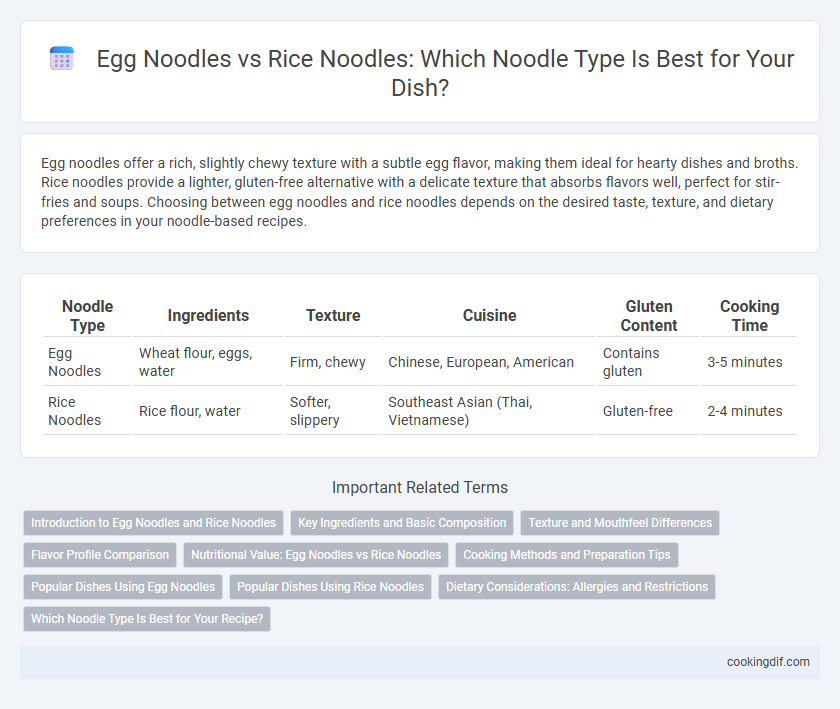Egg noodles offer a rich, slightly chewy texture with a subtle egg flavor, making them ideal for hearty dishes and broths. Rice noodles provide a lighter, gluten-free alternative with a delicate texture that absorbs flavors well, perfect for stir-fries and soups. Choosing between egg noodles and rice noodles depends on the desired taste, texture, and dietary preferences in your noodle-based recipes.
Table of Comparison
| Noodle Type | Ingredients | Texture | Cuisine | Gluten Content | Cooking Time |
|---|---|---|---|---|---|
| Egg Noodles | Wheat flour, eggs, water | Firm, chewy | Chinese, European, American | Contains gluten | 3-5 minutes |
| Rice Noodles | Rice flour, water | Softer, slippery | Southeast Asian (Thai, Vietnamese) | Gluten-free | 2-4 minutes |
Introduction to Egg Noodles and Rice Noodles
Egg noodles, made from wheat flour and enriched with eggs, offer a firm texture and rich flavor ideal for stir-frying and soups. Rice noodles, crafted from rice flour and water, provide a lighter, gluten-free alternative with a smooth, slippery texture suitable for dishes like pho and pad thai. Both noodle types contribute distinct culinary qualities, influencing dish authenticity and regional taste profiles.
Key Ingredients and Basic Composition
Egg noodles primarily contain wheat flour, eggs, and water, giving them a rich texture and yellow color due to the egg protein and yolk content. Rice noodles are made from rice flour and water, lacking gluten and eggs, making them lighter and more translucent. The presence of eggs in egg noodles results in a chewier consistency, whereas rice noodles offer a softer, more delicate bite ideal for gluten-free diets.
Texture and Mouthfeel Differences
Egg noodles have a firm, chewy texture with a slightly dense bite due to the inclusion of wheat flour and eggs, offering a rich mouthfeel that holds up well in hearty dishes. Rice noodles possess a delicate, smooth, and slightly slippery texture, creating a lighter, softer mouthfeel ideal for soups and stir-fries. The contrast in protein and starch composition between egg and rice noodles directly influences their cooking resilience and tactile eating experience.
Flavor Profile Comparison
Egg noodles offer a rich, savory flavor with a slightly chewy texture due to their wheat and egg content, making them ideal for robust, hearty dishes. Rice noodles have a mild, delicate taste with a soft and slippery texture, which allows them to absorb the flavors of accompanying sauces and broths effectively. The distinct flavor profiles of egg and rice noodles suit different culinary applications, with egg noodles complementing stronger, meat-based recipes while rice noodles enhance lighter, aromatic Asian dishes.
Nutritional Value: Egg Noodles vs Rice Noodles
Egg noodles typically contain higher protein and fat content due to the inclusion of eggs, providing essential amino acids and higher caloric value compared to rice noodles. Rice noodles are naturally gluten-free and lower in calories and fat, making them suitable for gluten-sensitive diets and calorie-conscious individuals. Both types offer carbohydrates for energy, but egg noodles tend to have a richer vitamin profile, including B vitamins from eggs, while rice noodles provide a lighter, easily digestible option.
Cooking Methods and Preparation Tips
Egg noodles, made from wheat flour and eggs, require boiling in rapidly simmering water for 3-5 minutes until tender, allowing them to retain a chewy texture ideal for soups and stir-fries. Rice noodles, composed of rice flour and water, benefit from soaking in warm water for 20-30 minutes or briefly boiling to achieve a soft consistency, making them perfect for dishes like Pad Thai and pho. Proper rinsing of rice noodles after cooking prevents clumping, while egg noodles should be drained and tossed with oil to maintain separation during stir-frying.
Popular Dishes Using Egg Noodles
Egg noodles, made from wheat flour and eggs, offer a rich, chewy texture that enhances dishes like Chicken Noodle Soup and Beef Stroganoff. Their ability to absorb flavors makes them ideal for hearty recipes such as Lo Mein and Malaysian Curry Mee. Unlike rice noodles, egg noodles provide a denser bite and are commonly found in comforting, protein-rich meals across Asian and Western cuisines.
Popular Dishes Using Rice Noodles
Rice noodles, made from rice flour and water, are a staple in many Asian cuisines due to their light texture and ability to absorb flavors well. Popular dishes featuring rice noodles include Pad Thai from Thailand, Pho from Vietnam, and Char Kway Teow from Malaysia, each highlighting the noodle's versatility and cultural significance. These noodles are often preferred in soups, stir-fries, and salads because they cook quickly and pair well with diverse ingredients like seafood, vegetables, and aromatic herbs.
Dietary Considerations: Allergies and Restrictions
Egg noodles contain wheat and eggs, making them unsuitable for individuals with gluten intolerance or egg allergies. Rice noodles are naturally gluten-free and often preferred by those with celiac disease or wheat allergies. Both types vary in protein content and texture, influencing dietary choices based on allergy and nutritional needs.
Which Noodle Type Is Best for Your Recipe?
Egg noodles offer a rich, chewy texture and are ideal for hearty dishes like stroganoff or soups requiring a robust noodle that holds sauce well. Rice noodles provide a lighter, gluten-free option with a delicate bite, perfect for stir-fries, pho, and fresh spring rolls where subtlety and absorbency are key. Choosing between egg noodles and rice noodles depends on your recipe's flavor intensity, dietary needs, and the desired noodle texture to best complement your dish.
egg noodles vs rice noodles for noodle type Infographic

 cookingdif.com
cookingdif.com